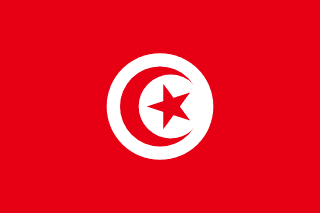Tunisia - Geography

Here, let us take a look at the Geography of Tunisia. Strategic location in central Mediterranean; Malta and Tunisia are discussing the commercial exploitation of the continental shelf between their countries, particularly for oil exploration. Mother's mean age at first birth is (), whereas, the Maternal mortality ratio is 37 deaths/100,000 live births (2020 est.)
Geographical data of Tunisia
| Location | Northern Africa, bordering the Mediterranean Sea, between Algeria and Libya |
|---|---|
| Geographic coordinates | 34 00 N, 9 00 E |
| Map references | Africa |
| Tarrain | mountains in north; hot, dry central plain; semiarid south merges into the Sahara |
| Natural Resources | petroleum, phosphates, iron ore, lead, zinc, salt |
| Natural Hazards | flooding; earthquakes; droughts |
| Irrigated Land | 3,920 sq km (2013) |
| Major rivers (by length in km) | |
| Major aquifers | North Western Sahara Aquifer System |
| Land Boundaries | 1,495 km |
| Border Countries | Algeria 1,034 km; Libya 461 km |
| Coastline | 1,148 km |
| Climate | temperate in north with mild, rainy winters and hot, dry summers; desert in south |
| Area | |
| Total Area | |
| Land Area | 155,360 sq km |
| Water Area | 8,250 sq km |
| comparative Area | slightly larger than Georgia |
| Maritime Claims | |
| Territorial sea | 12 nm |
| Contiguous zone | 24 nm |
| Exclusive economic zone | 12 nm |
| Elevations | |
| Highest point | Jebel ech Chambi 1,544 m |
| Lowest point | Shatt al Gharsah -17 m |
| Mean elevation | 246 m |
| Land Use | |
| Agricultural land | 62.4% (2022 est.) |
| Agricultural land: arable land | arable land: 18.2% (2022 est.) |
| Agricultural land: permanent crops | permanent crops: 13.6% (2022 est.) |
| Agricultural land: permanent pasture | permanent pasture: 30.6% (2022 est.) |
| Forest | 4.5% (2022 est.) |
| Other | 33% (2022 est.) |
Population Distribution
The overwhelming majority of the population is located in the northern half of the country; the south remains largely underpopulated as shown in this population distribution map
People and Society
In Tunisia, the different Ethnic groups are such that we have: Arab 98%, European 1%, Jewish and other 1%
| Population | |
|---|---|
| Pop growth rate | 0.58% (2024 est.) |
| Birth rate | 13.5 births/1,000 population (2024 est.) |
| Death rate | 6.4 deaths/1,000 population (2024 est.) |
| Health expenditure | 7% of GDP (2021) |
| Physicians Density | |
| Hospital bed Density | 2.2 beds/1,000 population (2017) |
| Total fertility rate | 1.93 children born/woman (2024 est.) |
| Gross reproduction rate | 0.94 (2024 est.) |
| Contraceptive prevalence rate | 50.7% (2018) |
| Est married women (ages 15-49) | 53.9% (2023 est.) |
| Literacy | age 15 and over can read and write |
| Education expenditures | 7.3% of GDP (2016 est.) |
| Net Migration rate | -1.3 migrant(s)/1,000 population (2024 est.) |
| Nationality | Tunisian | Tunisian(s) |
| Languages | |
| Religions | Muslim (official; Sunni) 99%, other (includes Christian, Jewish, Shia Muslim, and Baha'i) <1% |
| Age Structure | |
| 0-14 years | 24.4% (male 1,516,871/female 1,426,522) |
| 15-64 years | 65.2% (male 3,861,731/female 3,990,802) |
| 65 years and over | 10.4% (2024 est.) (male 593,640/female 659,281) |
| Dependency Ratios | |
| Total dependency ratio | 50.9 |
| Youth dependency ratio | 36.3 |
| Elderly dependency ratio | 13.3 |
| Potential support ratio | 7.5 (2021 est.) |
| Median Age | |
| Total | 34.4 years (2024 est.) |
| Male | 33.6 years |
| Female | 35.1 years |
| Urbanization | |
| Urban population | 70.5% of total population (2023) |
| Rate of urbanization | 1.34% annual rate of change (2020-25 est.) |
| Major urban areas (Pop) | 2.475 million TUNIS (capital) (2023). |
| Sex Ratio | |
| At birth | 1.06 male(s)/female |
| 0-14 years | 1.06 male(s)/female |
| 15-64 years | 0.97 male(s)/female |
| 65 years and over | 0.9 male(s)/female |
| Total population | 0.98 male(s)/female (2024 est.) |
| Infant Motality | |
| Total | 11.3 deaths/1,000 live births (2024 est.) |
| Male | 12.7 deaths/1,000 live births |
| Female | 9.8 deaths/1,000 live births |
| Life Expectancy at birth | |
| Total population | 77.3 years (2024 est.) |
| Male | 75.7 years |
| Female | 79.1 years |
| Drinking Water Sources | |
| Improved: urban | urban: 100% of population |
| Improved: rural | rural: 97.3% of population |
| Improved: total | total: 99.2% of population |
| Unimproved: urban | urban: 0% of population |
| Unimproved: rural | rural: 2.7% of population |
| Unimproved: total | total: 0.8% of population (2020 est.) |
| Sanitation facility acess | |
| Improved: urban | urban: 98.8% of population |
| Improved: rural | rural: 99.4% of population |
| Improved: total | total: 99% of population |
| Unimproved: urban | urban: 1.2% of population |
| Unimproved: rural | rural: 0.6% of population |
| Unimproved: total | total: 1% of population (2020 est.) |
| Alcohol consumption per capita | |
| Total | 1.51 liters of pure alcohol (2019 est.) |
| Beer | 0.99 liters of pure alcohol (2019 est.) |
| Wine | 0.32 liters of pure alcohol (2019 est.) |
| Spirits | 0.17 liters of pure alcohol (2019 est.) |
| Other alcohols | 0.03 liters of pure alcohol (2019 est.) |
| Tobacco use | |
| Total | 24.6% (2020 est.) |
| Male | 47.2% (2020 est.) |
| Female | 2% (2020 est.) |
| Child marriage | |
| Women married by age 15 | 1.5% (2018 est.) |
Demographic profile
All Important Facts about Tunisia
Want to know more about Tunisia? Check all different factbooks for Tunisia below.









